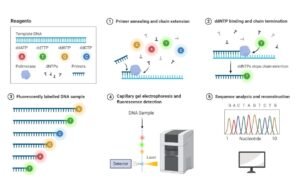Genetic testing at molecular level is done to identify deletion of genes, absence or addition of DNA regions, base pair variations within a gene or in between genes, single nucleotide changes, etc.
DNA can be isolated from almost any cell type like peripheral blood, epithelial cells (cheek swab), bone marrow, amniocytes, pap smear cells, or any surgically removed human material as a biopsy or as a surgical specimen.
The DNA thus obtained can be amplified by Polymerase chain reaction (PCR) and then analyzed by agarose gel electrophoresis, poly acrylamide gel electrophoresis, restriction enzyme digestion, sequencing etc.

Agarose gel showing absence of gene in one lane present in others indicating deletion

A gel with different bands showing the MTHFR gene variation after restriction enzyme digestion

Simple Steps in Sanger Sequencing
Next generation sequencing (NGS)
NGS utilizes technologies that are capable of processing multiple DNA sequences in parallel. The process involves fragmenting DNA into multiple pieces, adding adapters, sequencing the libraries, and reassembling them to form a genomic sequence. It is a low cost and high-throughput DNA sequencing producing millions of sequences concurrently in a very short time, hence requires computers and software for analysis.
The NGS based tests can determine several gene panels (several genes responsible for a specific condition), whole exome (all the coding genes in an individual) and whole genome (complete DNA sequence of an individual) in a cost effective manner.

Simple Steps in Next Generation Sequencing
